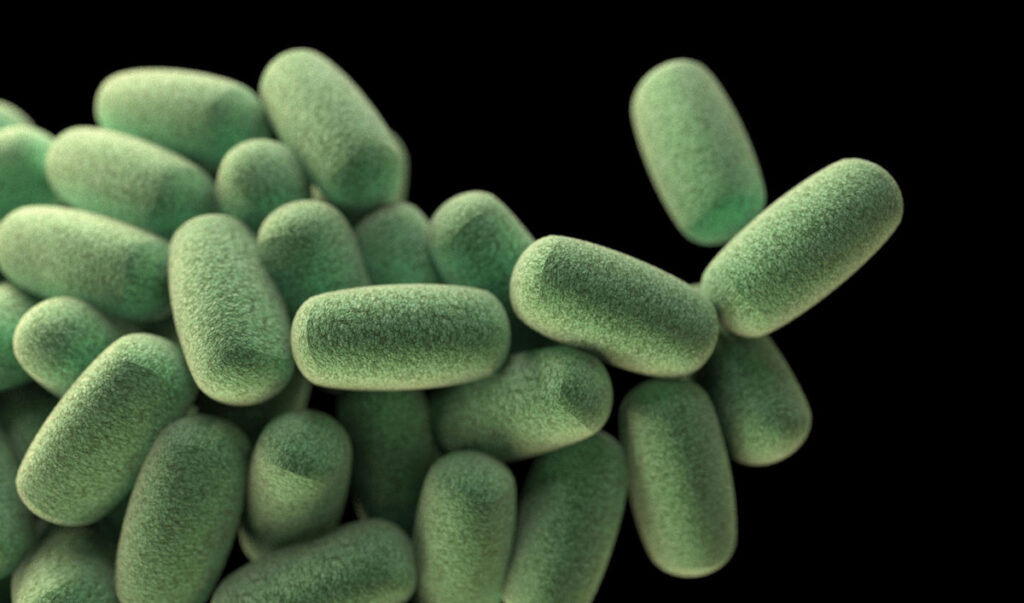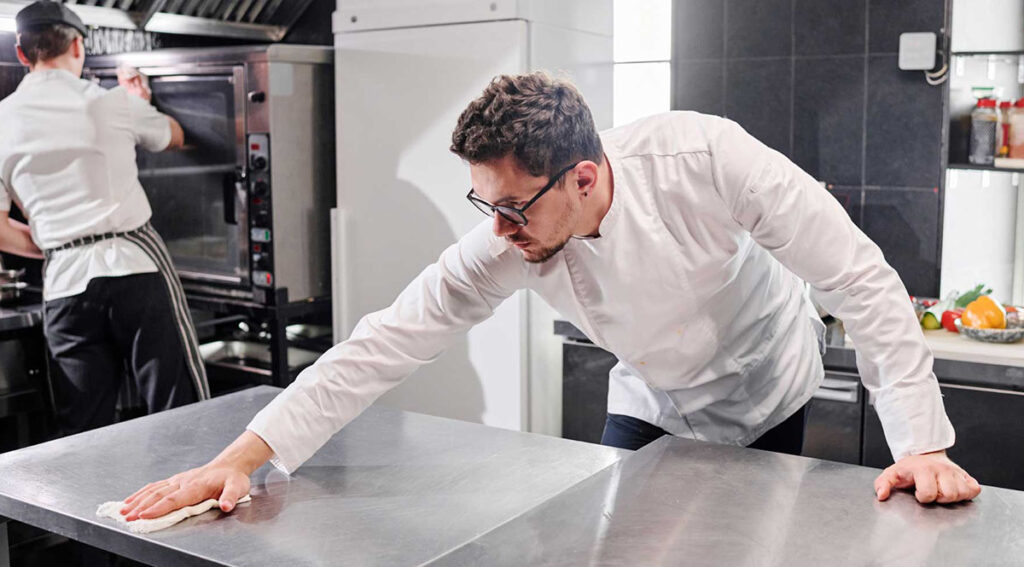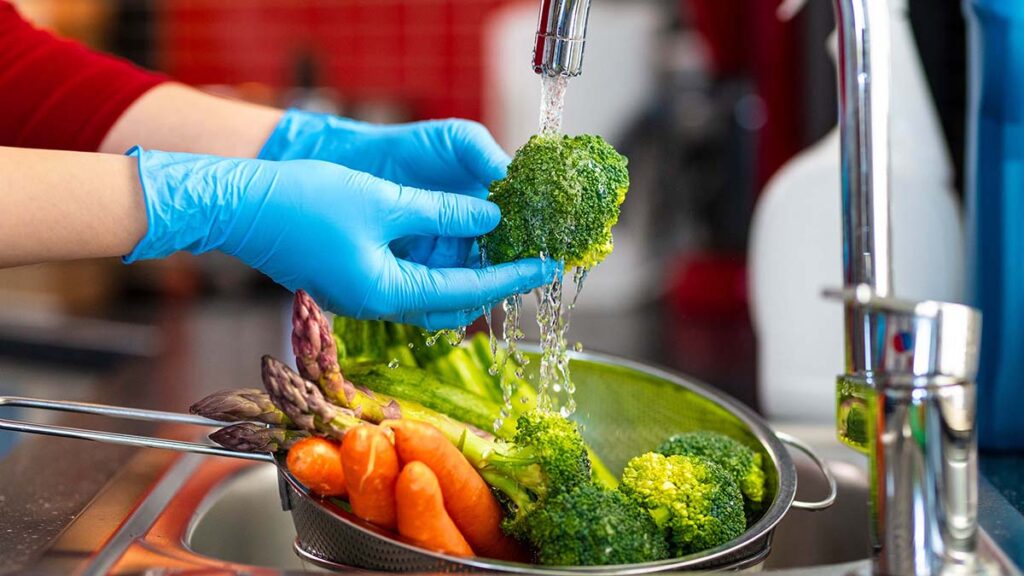Foodborne illnesses – stop them before they spread
If you’ve had food poisoning, you know it’s an experience you’d rather forget. Preventing foodborne illnesses from spreading is vital for any restaurant to keep patrons from having a similar experience. Learn more about common illnesses and how you and your staff can stop them in their tracks in your venue.
What are the five most common foodborne illnesses?
This list was compiled using information from the Centers for Disease Control (CDC). The list focuses on common germs and bacteria that cause illness within a restaurant setting – it’s by no means extensive.
If you would like to learn more about this subject, we recommend speaking directly to a healthcare professional.

1. Norovirus
Norovirus is a highly contagious virus that causes gastroenteritis, an inflammation of the stomach and intestines. If you’re unfamiliar with its formal name, don’t worry; Norovirus is often known as stomach flu.
A Norovirus infection is usually characterized by symptoms such as:
- nausea
- vomiting
- diarrhea, and
- stomach cramps.
These symptoms typically appear within 12 to 48 hours after exposure to the virus and can last for one to three days.
Norovirus is typically spread through contaminated food or water, but it can also be spread through contact with infected individuals or by touching contaminated surfaces with one’s mouth, nose, or eyes.
Outbreaks of norovirus commonly occur in settings where people are in close proximity to each other, such as cruise ships, schools, nursing homes, and restaurants.
The best way to treat Norovirus is to drink plenty of fluids and rest. If you can, self-isolate for a couple of days until symptoms decrease, and do not prepare food for anyone else to consume.
2. Salmonella
Arguably one of the most well-known bacteria in the world, Salmonella can cause food poisoning, known as salmonellosis, in humans. There are many different strains of Salmonella bacteria, with Salmonella enterica being the most common cause of illness in humans.
Salmonella infection typically results in symptoms such as:
- diarrhea
- abdominal cramps
- fever
- nausea, and
- vomiting.
These symptoms usually appear within six to 72 hours after exposure to the bacteria and can last for four to seven days. Generally, if you suffer from this poisoning, you can recover without specific treatment.
However, in some cases, particularly in young children, the elderly, or individuals with weakened immune systems, the infection can be severe and may require medical attention.
Salmonella bacteria are commonly found in raw or undercooked meat, poultry, eggs, and unpasteurized dairy products. On occasion, contaminated fruits, vegetables, and processed foods can also transmit the bacteria.
In addition to being spread via food, Salmonella can be spread through contact with infected animals or their environments, and through person-to-person contact.
3. Clostridium perfringens
Clostridium perfringens, which is usually shortened to just C.perfringens, is a type of bacteria commonly found in the natural environment, particularly in soil and dust. It can also be found in the gastrointestinal tracts of humans and animals.
While C. perfringens is usually harmless, certain strains of the bacteria can produce toxins that cause illness when ingested in large quantities.
Clostridium perfringens food poisoning typically occurs when foods are prepared in large quantities and kept warm for an extended period before serving. This allows the bacteria to multiply and produce toxins, which are not destroyed by cooking.
Symptoms of C. perfringens food poisoning usually develop within six to 24 hours after consuming contaminated food and commonly include abdominal cramps and diarrhea. Vomiting and fever may also occur but are less common.
Meat and poultry, particularly beef and turkey, as well as gravies, stews, and casseroles, are commonly associated with C. perfringens food poisoning. Improperly cooked or reheated foods and those kept warm for an extended period are at higher risk of contamination.
While C. perfringens food poisoning is generally not life-threatening, it can cause significant discomfort and inconvenience. Most people recover without medical treatment within a few days.

4. Campylobacter
Campylobacter is a genus of bacteria that can cause gastrointestinal illness in humans. The illness caused by Campylobacter infection typically presents with symptoms such as:
- diarrhea (often bloody)
- abdominal cramps
- fever
- nausea, and
- vomiting.
Symptoms usually appear two to five days after exposure to the bacteria and can last for about a week. Most cases of Campylobacter infection are self-limiting, meaning they resolve on their own without medical treatment. However, antibiotics may be prescribed in severe cases or in individuals with weakened immune systems.
Campylobacter bacteria are commonly found in the intestines of animals, particularly poultry (such as chickens and turkeys), cattle, and other domestic animals. Human infections often result from consuming contaminated food, particularly raw or undercooked poultry, unpasteurized milk, and untreated water.
5. Staphylococcal (Staph)
Staphylococcal, commonly referred to as Staph, food poisoning occurs when food contaminated with the Staphylococcus aureus toxins are consumed.
Staph food poisoning typically presents with symptoms such as:
- diarrhea
- abdominal cramps
- fever
- nausea, and
- vomiting.
These usually develop quickly, often within a few hours of consuming contaminated food, and can last for one to two days. Depending on the severity and type of infection, treatment of Staph infections may involve antibiotics. The severity of symptoms can vary depending on the amount of toxin ingested and individual susceptibility.
Foods commonly associated with Staph food poisoning include meat and poultry products, dairy products (particularly unpasteurized milk and cheese), egg products, salads, and sandwiches.
Improper food handling and storage practices, such as leaving cooked food at room temperature for an extended period or inadequate refrigeration, can allow Staph to multiply and produce toxins.

Ways to prevent the spread of these foodborne illnesses
You would’ve noticed all of the above illnesses have similar symptoms. They are also caused by similar actions – poor hygiene, food spoilage and improper food handling. As a result, use the following methods to help stamp out any potential issues from occurring.
Create handwashing principles
Make sure all staff wash their hands with soap and water often. They must do this properly for at least 20 seconds, especially after going to the bathroom, handling raw food, or touching dirty things.
Handle food safely
Train your staff to handle food safely, cook it well, and keep it separate from things that might make people sick. Avoid serving food that’s not fully cooked. Implement strict cleaning and sanitization rules for your restaurant kitchen surfaces, utensils, and equipment—because ultimately, food safety starts where a properly cleaned and sanitized food contact surface has been maintained consistently.

Keep the food cold or hot
Check your fridges, freezers, and food warmers are at the right temperatures to keep food safe. Throw away any food left out too long or at the wrong temperature. If you find it difficult to keep track of food expiry dates, our article on shelf-life tracking and food labeling is a great resource.
Don’t let sick staff handle food
Have a rule that sick staff can’t work, especially if they’ve been throwing up or have diarrhea. Give them time off so they can fully recover. This will help stop the spread of illness to other staff and offer the sick individual a chance to rest and return to work fit and healthy.
Teach staff how to spot illnesses
Staff should recognize when someone might be sick and then tell a manager immediately. If they feel sick, they should stay home until they’re better. If you need guidance on instilling this attitude in your staff, our article, ‘How to build a strong food safety culture’, is a handy guide for venue managers like yourself.
Use a restaurant cleaning checklist template
It helps if you and your staff have a guide to restaurant cleaning principles. From there, teach them the importance of restaurant-wide cleaning. Make sure the bathrooms are clean and have soap and paper towels. Regularly clean high-touch areas, like door handles and tables. Keep the restaurant kitchen and cooking tools clean, too.
Act fast if patrons get sick
If you hear about people getting sick after eating at your place, investigate right away. Work with health officials to figure out what happened and how to prevent it from happening again.
How Operandio can help
There is no comparison to Operandio for increased restaurant kitchen hygiene and sanitation efficiency. We can help you streamline your processes with digital cleaning checklists, Bluetooth probe integration, and wireless temperature monitoring. Book your free demo today and say goodbye to preventable foodborne illnesses.


